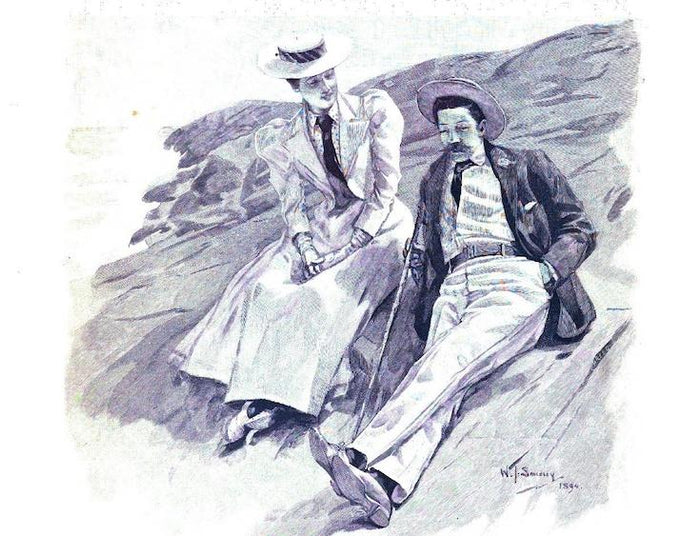The Defining Styles of English Sportswear

The peace and economic prosperity of Europe’s Belle Époque (1871-1914) nurtured an optimism and an artistic flowering that found an expression of liberated vitality among its youth.
The young men of Europe’s ‘Beautiful Era’ ceased to gain weight deliberately and tread heavily to affect the gravity of their elders, they no longer wore gold-rimmed spectacles, bought products designed to stimulate whisker growth, nor jackets that kept their legs warm. In 1890, the much-esteemed London trade journal Tailor & Cutter dispatched one of its staff writers to London’s Charring Cross station. Several hours of observation yielded a count of 150 frock coats, 320 morning coats and 530 lounge suits. Surprisingly, this ascendant new mode of business wear did not stem from its more stately town wear alternatives, but from the prevailing Europe-wide passion for sport, the greater opportunity for leisure afforded by the economic prosperity of the era, and the lead of the English sportsman with his ‘sports jacket’, ‘blazer’ and ‘flannels’.

Rowing, Lucien Davis, 1898.
Though extant in England in different incarnations for centuries, it was the use of the ‘sports jacket’ by Edward VII (1841-1910) and his grandson the Duke of Windsor (1894-1972) that most decisively popularised it into the form and character so familiar to us today. The ‘Norfolk jacket’ worn by Edward VII whilst flushing game on his Norfolk estate fast became the jacket par excellence for shooting, golf, cycling and hiking. The jacket had large bellowed patch pockets for the accommodation of powder flask, shot container and cartridges, a belt to bear the strain of full pockets, and ‘box pleats’ to allow for easy movement. Under the Duke of Windsor’s colourful sartorial ambassadorship, the ‘sports jacket’ reverted to a plainer cut with inset pockets. Plain, herringbone and houndstooth tweed gave way to larger ‘gun club’ and ‘glen’ plaids, and the tweed itself got softer. The Duke of Windsor also showcased the new ‘London cut’, which rather than stiffly reflecting the form of the wearer, continues to this day to softly bestow a flattering athletic V-shape.

While the precise origin of the ‘blazer’ is uncertain, its earliest recorded usage is not. The Cambridge University Almanack and Register for 1853 lists the correct uniform of the Lady Margaret Rowing Club of St. John’s College with the inclusion of a “red guernsey or ‘blazer’”, and for nearly three decades thereafter, the term ‘blazer’ was used exclusively in connection with the rowing clubs of the University of Cambridge. By 1880, the term had spread to cricket, when the stripes of the shirts worn with the white flannel cricket jacket were transferred to the jacket itself. By the 1890s, the blazer, whether striped or plain, was a common feature of all gamesmanship. On or about the river, the cricket and football pitch, the tennis court and the golf links, the blazer was typically single-breasted, unlined and with patch pockets. The lined jacket with inset pockets to which the term ‘blazer’ is now generally applied derives its form - and its gilt buttons - from the ‘reefer’ jacket worn by officers of the Royal Navy. The popularity of this jacket owes much to the royal obsession with yachting begun by the English Restoration Court of Charles II, to the annual regatta at Cowes on the Isle of White, and to Coco Chanel’s days - and nights - aboard the 2nd Duke of Westminster’s yacht The Flying Cloud.

Until the end of the Great War, the Englishman wore his blazer with white flannel trousers, and his sports jackets with matching knickerbockers. At the end of the war, English grey flannel trousers took the world by storm. Known as ‘grayers’, the new trousers were paired both with the sports jacket and the blazer, and made available in every shade of grey from pearl to lead. The new ‘grayer’ celebrated skilful mixes of black, grey and white fibres that could produce many highlights and sheen. On a trip to Africa in 1932, French author and ethnographer Michel Leiris was taken aback by the elegance of a Scottish civil servant in “dazzling” grey flannel trousers. During the mid-1920s, the ‘young bloods’ who’d rode the wave of the 40” bottom ‘Oxford bags’ started to push for, and then wear, flannels in pale tan and pastel shades. This plain flannel became worsted in the 1930s before the plain and checked tweed of the 1940s superseded flannel, and ‘gabardine’, ‘cavalry twill’, ‘whipcord’ and ‘corduroy’ became the favourite sports trousering of the 1950s.

Before meeting Ernest Asser in 1893, John Arthur Turnbull had already distinguished himself among England’s sporting gentry as an innovator of clothing for the hunting field. By the 1930s, the pair had established themselves further as clothiers for the steeplechase, the covert, the stream, the golf links, the polo field and the wicket. Evident still in the insignia of the gilt buttons of Turnbull & Asser’s house blazers is the company’s lapsed association with England’s oldest hunt, the Quorn. The retention of the insignia is symbolic of Turnbull & Asser’s continuing innovative responsiveness to the sporting and leisure proclivities of each epoch of its existence, and its commitment ever to remain in the foreground of the definition of the defining styles of English sportswear.



